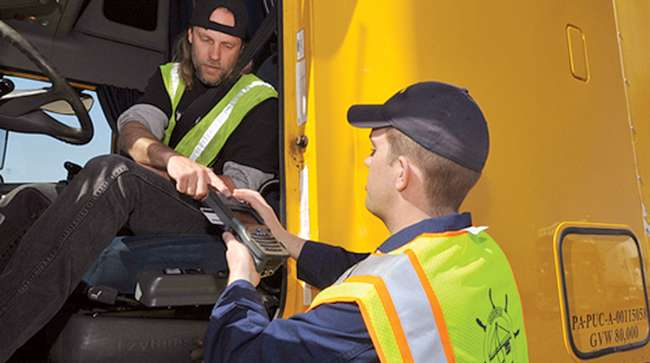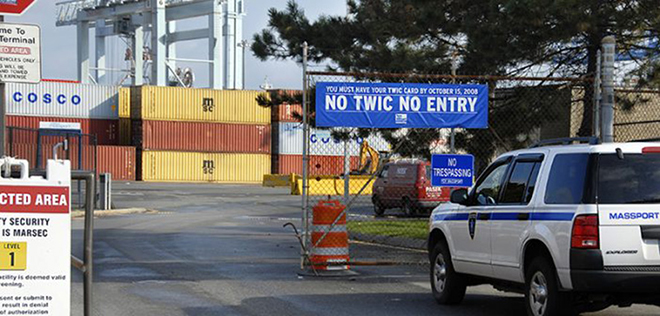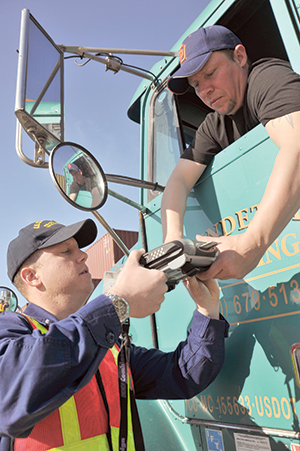Senior Reporter
Coast Guard Delays Deployment of TWIC Card Readers at Some Chemical Facilities

In an apparent reaction to pressure from a number of associations representing chemical, petroleum, manufacturing and business trade groups, the U.S. Coast Guard on June 21 announced plans to delay for three years a requirement that hundreds of bulk cargo facilities deploy Transportation Worker Identification Credential biometric card readers by Aug. 23.
A pre-publication version of a notice of proposed rulemaking said the delay will include some facilities that handle certain dangerous cargoes in bulk — such as chemicals and gasoline — but does not include a delay for facilities that receive large passenger vessels and facilities that handle bulk shipments of certain dangerous cargoes and transfer them to or from a vessel. Those facilities would still need to meet the Aug. 23 deployment date, according to the proposed rule.
Scott Jensen, a spokesman for the American Chemistry Council, called the proposal a “partial victory” for the 11 trade groups that have for months been seeking the delay.
“It looks like a partial delay,” Jensen told Transport Topics. “It looks like it will not impact all of the facilities.”
Jamie Conrad, a Washington attorney representing three of the affected facilities in a federal lawsuit over the requirement, estimated the proposal would include about three-fourths of the potentially affected facilities, leaving hundreds still bound by the Aug. 23 deployment date.

Conley Terminal in Massachusetts (U.S. Coast Guard)
“What we asked for is for them to extend the effective date for all Risk Group A covered facilities,” Conrad told TT. “A partial delay like this raises the prospect that some people have to comply partly now and partly later. It would be more efficient if people had to do it all at once.”
“There is some confusion about whether they have to comply now to some extent and have to put readers at the docks, and then three years from now have to have readers at truck gates,” Conrad added.
In a letter sent earlier this month to leaders in the U.S. House of Representatives, the 11 groups asked legislators involved in homeland security to pass the Transportation Worker Identification Credential Accountability Act of 2018, (H.R. 5729), which would require the U.S. Department of Homeland Security to first complete an assessment of the effectiveness of the current TWIC reader program before requiring the reader deployments. The group complained that the agency has unfairly expanded the requirement for up to 2,000 chemical and gasoline facilities that federal authorities say handle “certain dangerous cargo in bulk.”
The American Chemistry Council, American Petroleum Institute, National Association of Manufacturers, U.S. Chamber of Commerce and Agricultural Retailers Association were among the letter signers.
A Senate version of the House bill (S. 3094) was introduced on June 20, but neither bill has made it to a floor vote.
In a federal lawsuit filed in April, three of the groups alleged that the U.S. Coast Guard, which oversees TWIC enforcement in port and other cargo facilities, issued a final rule that was “a surprise to the regulated community” since it differed from an earlier NPRM, according to Jensen. The lawsuit’s plaintiffs were the American Chemistry Council, the International Liquid Terminals Association and the Fertilizer Institute.

A driver's TWIC card is checked at the Port of Baltimore. (U.S. Coast Guard)
The groups said expanding the number of facilities covered in a final rule without following the proper regulatory steps was a violation of the Administrative Procedure Act and are seeking to delay the effective date of the rule. A federal judge has scheduled a July 24 hearing on the trade associations’ motion to stay the effective date of the Coast Guard’s TWIC reader rule.
The TWIC is a tamper- and counterfeit-resistant biometric smart card credential used mostly by transportation workers that allows them access to port facilities without an escort.
Homeland security officials identified three possible scenarios in their “risk analysis methodology” that TWIC card readers could help stop. They were a truck bomb, a terrorist assault team and an explosive attack carried out by a passenger or passerby.
In May of 2013, the Government Accountability Office issued a report questioning the TWIC reader program’s effectiveness in enhancing security, calling on Congress to halt the promulgation of a final rule until the completion of a security assessment. In response, Congress passed legislation in December 2016 requiring DHS to conduct an assessment of the TWIC program. So far that hasn’t happened, but the Coast Guard has instead been moving to require more readers be installed at more facilities. Installing those TWIC readers could collectively cost the facilities a total of $26 million, or more, according to the lawsuit.
A statement issued earlier this year by the National Association of Manufacturers said the TWIC reader requirement “runs counter to manufacturers’ efforts to efficiently and effectively protect their facilities,” and that the 2016 final rule “not only lacks regulatory certainty, but also creates significant logistical challenges for the regulated community.”



